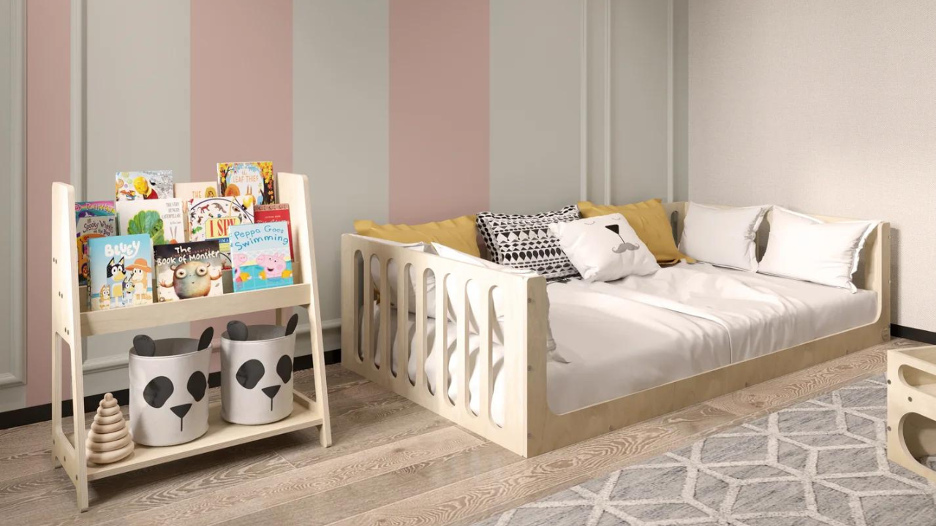Why Montessori Floor Beds Are Taking Over Cribs

Montessori education, developed by Maria Montessori, emphasizes independence, freedom within limits, and respect for a child’s natural psychological, physical, and social development. One of the key aspects of Montessori philosophy applied in infant and toddler environments is the use of a floor bed or a Montessori crib instead of traditional cribs. This essay aims to provide an in-depth evaluation of both the Montessori bed and the Montessori crib, exploring their principles, advantages, disadvantages, and their impact on infant development.
Before delving into the specifics of the Montessori bed and crib, it’s essential to grasp the fundamental principles of Montessori philosophy. Maria Montessori emphasized the importance of providing children with an environment that promotes independence, exploration, and freedom of movement. In the context of infant sleep environments, this philosophy translates into the creation of a space that allows babies to move freely and develop at their own pace.
Montessori Floor Bed
The Montessori bed is a low, mattress-style bed placed directly on the floor, without any barriers or boundaries. It allows infants to move in and out of bed independently, encouraging self-regulation and exploration. Advocates of the Montessori floor bed argue that it promotes physical freedom, autonomy, and enhances the development of gross motor skills. Additionally, proponents suggest that the floor bed facilitates bonding between caregivers and infants, as it encourages co-sleeping and close physical proximity.
Advantages of Montessori Floor Bed
- Freedom of Movement: Infants can move in and out of bed without constraints, promoting independence and self-exploration.
- Self-Regulation: Babies learn to regulate their sleep patterns and behaviors without external intervention.
- Bonding Opportunities: Co-sleeping on a floor bed fosters a strong bond between caregivers and infants, promoting attachment and security.
- Development of Gross Motor Skills: The unrestricted space around the floor bed allows infants to practice crawling, rolling, and other motor skills.
- Natural Sleep Environment: The absence of barriers creates a calming and natural sleep environment, conducive to restful sleep.
Disadvantages of Montessori Floor Bed
- Safety Concerns: Critics argue that the lack of boundaries poses safety risks, such as falls or entrapment.
- Transition Challenges: Some babies may have difficulty adjusting to the transition from a traditional crib to a floor bed, leading to disrupted sleep patterns.
- Limited Age Range: While suitable for infants and toddlers, the floor bed may become impractical as children grow older and require more structured sleep arrangements.
Montessori Crib
The Montessori crib, also known as a floor-level crib or low-profile crib, shares some similarities with the traditional crib but is designed to align with Montessori principles. Unlike standard cribs with high railings, the Montessori crib features low or removable barriers, allowing infants to enter and exit the crib independently. The goal is to provide a safe sleep environment while still promoting autonomy and freedom of movement.
Advantages of Montessori Crib
- Safety: The low barriers of the Montessori crib reduce the risk of falls while still providing a secure sleep space for infants.
- Independence: Infants can enter and exit the crib independently, fostering a sense of autonomy and self-confidence.
- Gradual Transition: The Montessori crib offers a middle ground between traditional cribs and floor beds, allowing for a gradual transition to independent sleeping.
- Bonding: Caregivers can easily access their infants for feeding, comforting, or bonding, promoting attachment and security.
- Flexibility: Some Montessori cribs feature removable barriers, providing flexibility as infants grow and develop.
Disadvantages of Montessori Crib
- Limited Freedom: Despite lower barriers, the crib still imposes some restrictions on movement compared to a floor bed.
- Space Constraints: The presence of a crib may limit floor space in the infant’s room, reducing opportunities for exploration and movement.
- Cost: Montessori cribs may be more expensive than traditional cribs due to their specialized design and features.
Comparison and Conclusion
Both the Montessori floor bed and Montessori crib offer unique benefits and challenges, catering to different parenting styles and infant needs. The floor bed prioritizes freedom of movement, independence, and bonding, while the crib provides a balance between safety and autonomy. Ultimately, the choice between a floor bed and a crib depends on factors such as parental preferences, safety considerations, and the child’s developmental stage. Regardless of the chosen sleep environment, implementing Montessori principles can promote healthy infant development and foster a nurturing, supportive atmosphere for young children to thrive.
Both the Montessori floor bed and Montessori crib embody the principles of Montessori education, emphasizing independence, freedom, and respect for the child’s developmental journey. By understanding the advantages and disadvantages of each option, parents can make informed decisions that align with their values and goals for their child’s growth and well-being.






